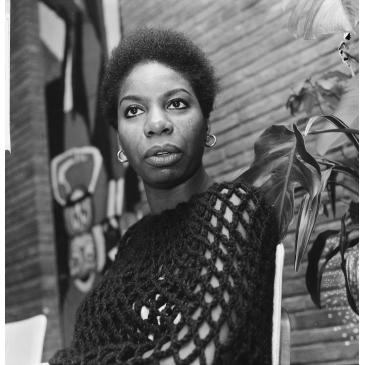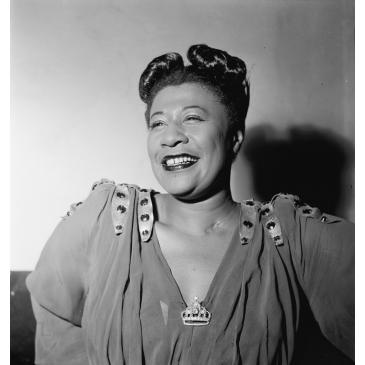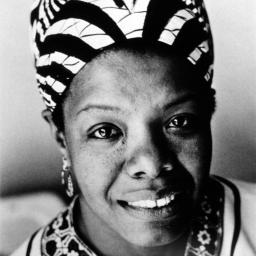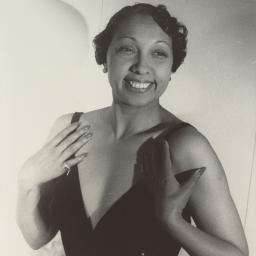Celia Cruz
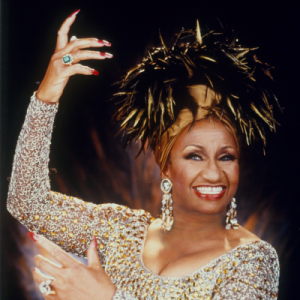
Celia Cruz, known as the Queen of Salsa, was an internationally acclaimed singer and dynamic stage performer from the 1940s to the start of the 21st century.
Celia Cruz was instrumental to the creation and popularization of “salsa,” a new genre of pan-Hispanic music that emerged in the 1960s.
Her long, versatile career broadened the reach of Caribbean and Latin American music, celebrating its African roots.
“Toda la vida, yo he cantado musica alegre; . . . no me gusta cantar nada triste. Pues debo tener mis momentos de tristeza … pero eso es para mi, para mi interior. . . no quiero transmitir al público.”
[All my life, I’ve sung happy music; I don’t like to sing anything sad. Of course I have unhappy moments, but they are just for me, for my inner life. I don’t want to bring that to the public.]
-“Me Llamo Celia Cruz,” BBC documentary (1988)
Becoming a Singer: La Guarachera de Cuba
The Queen of Salsa was born Celia Caridad Cruz Alfonso on October 21, 1925, in Havana, Cuba. Her parents, siblings, half siblings, and cousins made a large, lively household in the Santos Suárez neighborhood. They struggled economically to stretch the salary her father earned as a railway worker. For a time, young Cruz lived with an aunt and always thought of her Tía Ana as a second mother. One of the oldest children in her extended family, her earliest memories of using her musical talent were of singing the younger ones to sleep – not only with conventional lullabies, but with any songs that came into her head.
Soon Cruz began winning talent contests sponsored by local radio stations. In the 1930s and 1940s, radio was the most important form of popular entertainment in Cuba, as it was throughout the world. Programming included radionovelas (soap operas), sports, and live music, including amateur competitions. Cruz could not always afford the fare to ride public transportation to the radio station, but she regularly brought home prizes such as cake, chocolate, soap, and once a silver necklace. (Fernandez 2006)
Cruz dreamed of making singing her profession, but her father was initially against the idea. Popular music was not considered a respectable occupation, especially for women; dominated by men and anchored in nightclubs, the industry was associated with alcohol, drugs, and sex work, as well as being rife with sexual harassment. Cruz studied to become a teacher instead. Nevertheless, she continued to sing, both on the radio and with bands at neighborhood dances. Eventually, her talent overcame her father’s opposition, and Cruz enrolled at the national music conservatory.
As her singing career began in earnest, Cruz performed with various groups on different radio stations. CMQ featured her regularly on its show, “Estrellas Nacientes” (Rising Stars) on Sunday afternoons. (Marceles 2004) Cruz’s gift for versatility led her to perform many different genres though traditional Cuban music. Her specialties were rumba, with its rhythmic origins in the African diaspora, and guaracha, with its fast tempo and saucy lyrics.
At the same time, as a dark-complexioned Afro-Cuban woman, Cruz faced multiple overlapping forms of discrimination. To build a successful career as a performer, Cruz had to overcome racialized beauty ideals that disparaged her skin color and features. Racism, sexism, and colorism in the music industry – and the culture at large – challenged Cruz throughout her life.
In 1950, Cruz became the new lead singer for Radio Progreso’s immensely popular band, La Orquesta Sonora Matancera. It was her big break – and theirs as well, in that the group reached its highest ratings with Cruz as their vocalist. (Marceles 2004), Cuban music was becoming increasingly popular throughout the world. This was largely enabled by the continued growth of radio on the island. Cuba had 145 radio stations by 1958. Places to dance and listen to live music abounded in La Habana as well; tourists flocked to the city’s famous nightclubs and cabarets. (Moore 2006) Building on its local acclaim, La Sonora Matancera performed throughout Latin America and recorded with the New York-based label Seeco. When their song “Burundanga” (1953) sold enough copies to “go gold,” Cruz took her first trip to the U.S. She ended up spending most of her life there.
Exilio y Exito / Exile and Success
Despite all her early success, the Cold War and the Cuban Revolution disrupted Celia Cruz’s life and career. Although she always thought of Cuba as mi tierra (her homeland), the change in regime made her country feel increasingly unlivable for Cruz. Fidel Castro’s new government enacted Socialist reforms, including the nationalization of media and other key industries. Nightclubs, associated with capitalist decadence, were closed, and artists expected to produce work that endorsed the party in power. (Moore 2006)
On June 15, 1960, the Sonora Matancera flew from Cuba to Mexico for what seemed like a routine concert tour. They never went back. Like almost half a million other Cuban political exiles, they found refuge in the United States. The Cuban government denied Cruz’s subsequent requests to return, including when her mother was dying. Cruz deeply regretted never being able to go to Cuba again, even to visit her parent’s graves. (Cruz 2004) The closest she came was in 1990, when she performed at the U.S. naval base in Guantánamo Bay – on the same island, but divided from the country of Cuba by a barbed wire fence.
After years of friendship, romantic love blossomed between Cruz and the Sonora Matancera’s trumpeter, Pedro Knight. They married in a simple ceremony in Connecticut in 1962. Knight became her manager and encouraged her to strike out independently. Cruz continued performing, recording, and touring with the band, working over half each year in Mexico (Cruz 2004). Her musicality and influence often inspired comparisons to another legendary American singer, Ella Fitzgerald.
After her emigration to the U.S., Cruz adopted her iconic exclamation ¡AZUCAR! liberally in her performances. She claimed that her interjection originated at a Miami restaurant, where she was shocked by the question of whether she wanted sugar in her coffee. (Cruz 2004) She used the word when singing to express intense joy in the sweetness of the moment. At the same time, its literal meaning (sugar) evoked her Spanish-speaking, Afro-Cuban identity. Cuba’s economy rested on sugar production, which had historically depended on Black enslaved labor and the African diaspora. Living as an exile, Cruz had to assert her passion for sugar and, through it, her very Cubanidad.
The Birth of “Salsa”
Cruz made her last record for Secco in 1965 and signed with Tico records, a smaller label specializing in mambo (a Cuban genre) and Latin soul. There she joined Tito Puente, Ray Baretta, and other Hispanic music legends. Fania, a new label co-founded by Dominican-born musician Johnny Pacheco, bought Tico Records several years later. Celia developed rich collaborative relationships with fellow artists, from veterans like Pacheco to newer luminaries like Willie Colón. Alongside her solo work, Cruz released albums, performed in concerts around the world, and made documentaries and television shows as part of the Fania All-Stars.
These artists incorporated electric instruments and emphasized Afro-Cuban rhythms in their music. They started calling their pan-Latin performances “salsa.” Re-imagined as salsa, Afrocaribbean music gained the power to attract younger audiences in a popular market dominated by rock. The potential for salsa fans grew alongside increasing Latin American migration to the United States, especially after changes to federal immigration law in 1965. (Ojito 1998) Cruz’s “Quimbara” – from the album “Celia y Johnny,” 1973 – became “a signature song” of the new genre. (Abreu 2015)
Celia first visited Africa in 1974, when the Fania All-Stars went to perform in Kinshasa, Zaire (now Democratic Republic of the Congo). Their stadium concert accompanied the iconic boxing match between Muhammad Ali and George Foreman, known as the “Rumble in the Jungle.” Celia felt deeply moved by the crowd’s enthusiastic response to her “Guantanamera;” she was amazed that her version of a Cuban anthem had reached so far.
Cruz stood out as one of the only women in the new world of salsa music. She used her deep “percussive” contralto voice to claim songs traditionally reserved for male vocalists. (Pareles 1985) At the same time, she maintained a flashy, feminine public persona. Her flamboyant style celebrated both her womanhood and her Blackness. She emphasized her Afro-Cuban roots, for instance in the bata cubana (Cuban dress), her preferred costume for performances from Carnegie Hall to the children’s television show Sesame Street. Traditionally worn by rumba dancers, the bata cubana combined Spanish and African elements. (Azúcar!)
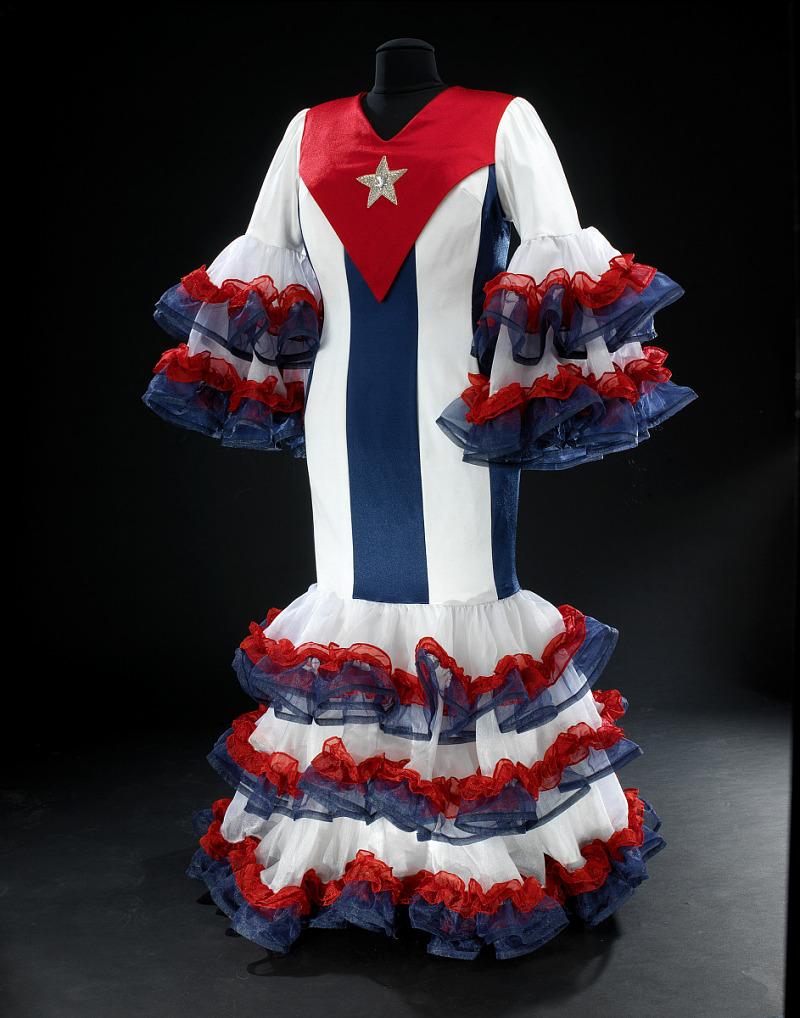
Like her music, Cruz’s fashion sense embraced the new. She gloried in the cultural celebration of Black culture and beauty in the 1960s and 1970s. She sometimes styled her hair into cornrows, and she chose to wear an Afro halo on the album cover for “Celia and Johnny.” From the early 1980s onward, she reveled in fantastical wigs, sequins and ruffles, dark eyeshadow and big false lashes, along with the bold colors she had always loved. Working with stylist Ruth Sanchez, Celia layered accessories and jewelry (Cobo 2007). Custom designs by Narciso Rodriguez and Miguel Nieto augmented her ebullient stage presence.
A Music Icon
Celia Cruz kept innovating and experimenting with new genres – pop, rock, and rap – into the twenty-first century, topping charts and winning music awards. Her lifelong love of collaboration, dedication to her fans, and genius for improvisation, all enabled her to keep evolving her sound and to remain relevant to audiences. Her version of “Guantanamera” with Haitian rapper Wyclef Jean won a Grammy nomination in 1998. Two years later, she won her first of five Grammy awards, for the album “Ritmo en el corazón,” a collaboration with Ray Barretto.
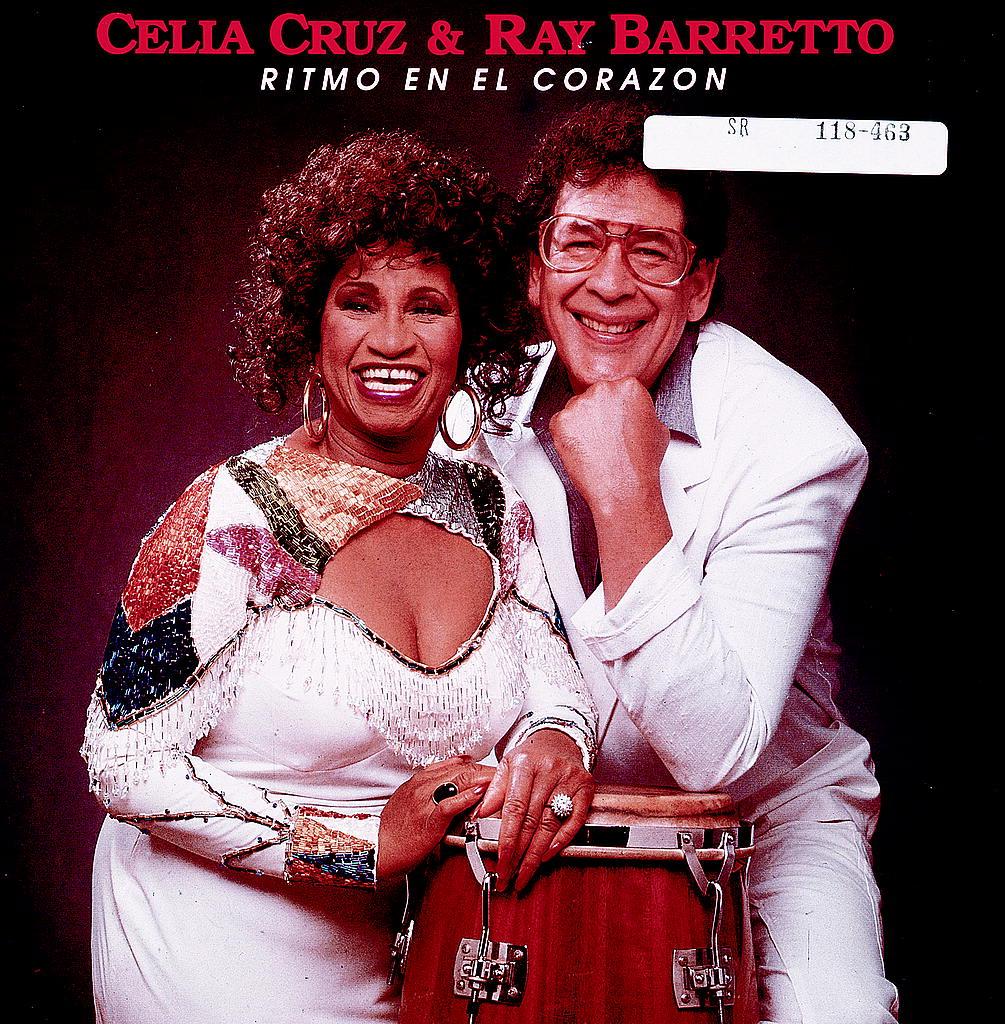
The accolades kept accumulating: a Hollywood Star, followed by a place on the Walk of Fame on Miami’s Calle Ocho and the Wall of Fame at Madison Square Garden; a Smithsonian Lifetime Achievement award, National Endowment for the Arts medal, honorary doctorates, selection as Telemundo’s Artist of the Millennium. She recorded two of her most popular songs, “La Vida es un Carnaval” (1998) and “La Negra Tiene Tumbao” (2001), in her 70s. Her very last album, “Regalo del Alma” (Sony, 2002), won a Grammy for the year’s best salsa album.
Cruz became a naturalized U.S. citizen in 1977, yet she always thought of Cuba as her home. Cuban American exiles embraced her “Canto a la Habana” as their unofficial national anthem. Cruz openly avowed her opposition to Communism, to the Cuban revolution, and to the government it installed. When challenged for her outspokenness, she’d reply, “How could I not say anything when I had the freedom to do so?” (Cruz 2004) She repeatedly refused to perform on the same stage as Cuban musicians. At the same time, Cruz largely kept her music separate from politics. “No hago de mi arte una bandera politica,” she asserted. “Quienes me oyen cantar pueden tener cualquier política. Yo no canto para ofender a nadie.” (I don’t make my art into a political banner. Those who listen to me can have any political position. I don’t sing to offend anybody.)
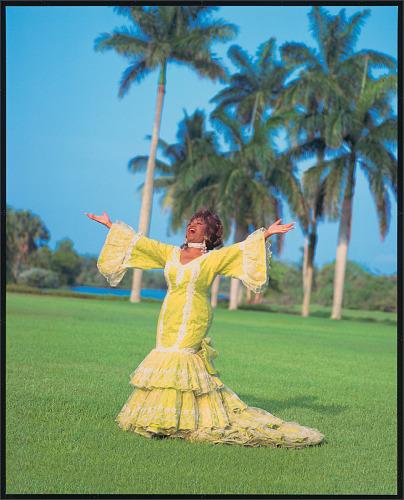
After a world tour in 2002, Cruz was diagnosed with breast cancer and underwent treatment. A brain tumor followed. She kept her struggles with her health private, wishing to maintain her exuberant, joyful public persona for her fans. On July 16, 2003, less than four months after Telemundo’s tribute to her in Miami Beach, Celia Cruz passed away at her home in New Jersey.
In recognition of Celia Cruz’s iconic contributions, the U.S. Congress awarded her a Congressional Gold Medal in 2005. In 2024, the U.S. Mint released a special quarter featuring Celia Cruz as part of the American Women Quarters™ Program. She had recorded over 70 albums, powerfully representing a range of musical styles, from orishas to boleros to a Beatles tribute. She had joyfully entertained audiences across the Americas, Europe, Africa, and Asia, performing in venues from the prestigious Carnegie Hall to street festivals. Even though – as she would say – “my English is not very good looking,” her popularity transcended languages, national boundaries, ethnicities, and generations. Cruz nurtured deep personal connections with her fans, including with children like Omer Pardillo and Luisito Falcón who became part of her family circle. (Marceles 2004)
That relationship to her listeners was a sacred trust for Cruz. She regarded it as the key to the success she had enjoyed. “I have always been a singer of the people,” she reflected. “If my fans ask me for something, I try my best to please them, and I don’t impose on them what I think they should like.” (Cruz 2004) Above all, she communicated an intensely jubilant sense of life, confronting migration, exile, and personal pain with defiant optimism. Her voice celebrates the choice to find beauty, joy, and hope in the world’s ever-changing nature.
 Primary Sources Analysis Strategies
Primary Sources Analysis Strategies
Caption: The song “Quimbara” was originally recorded by Celia Cruz and Dominican-born musician Johnny Pacheco on their album, “Celia y Johnny” (Fania Records, 1974). The Bantu word “quimbara,” repeated throughout the song, has no exact English translation.
Analysis Questions:
- What mood do you think this song was trying to create? How do you think the musicians would want us to respond to its sound?
- What elements of the recording might reflect the African roots of Caribbean music? Think about the rhythms and the musical instruments, for example.
- Can you understand the lyrics to “Quimbara”? What language (or languages) are they sung in? What does that suggest about the audiences for salsa music?
Educator Notes:
Educators can start staging their inquiry of this image using the Teaching with Primary Sources Library of Congress Teacher’s Guide: Analyzing Sound Recordings
Learn more about the album: https://www.loc.gov/static/programs/national-recording-preservation-board/documents/CeliaAndJohnny.pdf
Celia Cruz’s bata cubana
Caption: This satin costume, made for Celia Cruz, is a bata cubana (Cuban dress) a style traditionally worn by rumba performers. It once had a long train attached with velcro. The designer, Irma Peñalver, reported that it was Cruz’s own idea to make a rumba outfit with a Cuban flag.
Analysis Questions:
- How would you describe the colors, style, ornamentation, and silhouette of this dress?
- Cruz often wore vividly colored rumba dresses when she sang. Why do you think Cruz chose to wear this type of clothing on stage? Why would she want to have a bata cubana that evokes a Cuban flag?
- What does this dress suggest about Cruz’s performance style? What other objects might help document her live shows?
Educator Notes:
Educators can start staging their inquiry of this image using the Teaching with Primary Sources Analyzing Photographs and Prints Guide: https://www.loc.gov/static/programs/teachers/getting-started-with-primary-sources/documents/Analyzing_Photographs_and_Prints.pdf
Explore more about her bata cubana: https://oncubanews.com/opinion/columnas/firmas-y-huellas/irma-penalver-modista-de-celia-cruz/
Album cover, Ritmo en el Corazón, 1988.
Caption: Fania Records released Celia Cruz and Ray Barretto’s album “Ritmo en el Corazón” (Rhythm in the Heart) in 1988. The collaborative project won a Grammy (Barretta’s first) in 1990.
Analysis Questions:
- What do you expect the music in this album to sound like, judging from the album cover photo?
- What is the significance of including a conga drum on the cover?
- Look closely at Cruz’s clothes, accessories, and hair in this image. How would you describe the look she chose? How does it compare with that of her collaborator, Ray Barretto?
Educator Notes:
Educators can start staging their inquiry of this album cover using the Teaching with Primary Sources Analyzing Photographs and Prints Guide: https://www.loc.gov/static/programs/teachers/getting-started-with-primary-sources/documents/Analyzing_Photographs_and_Prints.pdf
Celia Cruz photo
Caption: Celia Cruz’s friend, Cuban-born artist and author Alexis Rodríguez-Duarte, took this photographic portrait of her in Miami in 1994.
Analysis Questions:
- Find visual details that provide clues about Cruz’s personality and personal identity, as well as to why she is famous. What might a person viewing this photo guess about who she was, even if they did not know anything about her?
- Why do you think Alexis Rodríguez-Duarte photographed Cruz in this outdoor setting, instead of on stage or in a recording studio?
- Compare Alexis Rodríguez-Duarte’s photo to this earlier photograph of Cruz from 1962, much earlier in her career. What similarities and differences do you note? What do the two photos together tell us about Cruz’s career?
Educator Notes:
Educators can start staging their inquiry of this image using the Teaching with Primary Sources Analyzing Photographs and Prints Guide: https://www.loc.gov/static/programs/teachers/getting-started-with-primary-sources/documents/Analyzing_Photographs_and_Prints.pdf
Learn more about the photographer: https://moadmdc.org/exhibitions/cuba-out-of-cuba-through-the-lens-of-alexis-rodriguez-duarte-in-collaboration-with-tico-torres
Caption: “La Vida Es Un Carnaval” (Life is a Carnival), written by Victor Daniel, was the lead single on Celia Cruz’s solo album “Mi Vida Es Cantar” (My Life Is Singing) from 1998. It became one of Cruz’s most popular songs and has been covered by many other artists.
Lyrics:
Todo aquel que piense que la vida siempre es cruel
Tiene que saber que no es así
Que tan solo hay momentos malos y todo pasa
Todo aquel que piense que esto nunca va a cambiar
Tiene que saber que no es así
Que al mal tiempo, buena cara, y todo cambia
Ay, no hay que llorar (No hay que llorar)
Que la vida es un carnaval
Y es más bello vivir cantando
Translation:
Everyone who thinks that life is always cruel
Has to know it isn’t that way
The bad times are only moments; they will pass
Everyone who thinks that this is never going to change
Has to know it isn’t that way
Do your best to face bad times; and everything will change
Ay, there’s no need to cry (There’s no need to cry)
Life is a carnival
And it’s more beautiful to live one’s life singing
Educator Notes:
Educators can start staging their inquiry of this image using the Teaching with Primary Sources Library of Congress Teacher’s Guide: Analyzing Sound Recordings
- Abreu, Christina D. Rhythms of Race: Cuban Musicians and the Making of Latino New York City and Miami, 1940-1960. University of North Carolina Press, 2015.
- “Azúcar! The Life and Music of Celia Cruz.” National Museum of American History, Washington DC. May 18, 2005 – May 29, 2006. https://www.si.edu/exhibitions/azucar-life-and-music-celia-cruz%3Aevent-exhib-2793. Archived site snapshot, https://wayback.archive-it.org/3340/20210119192055/https://amhistory.si.edu/celiacruz/printable/
- Cobo, Leila. “Salsa queen's over-the-top style lives again in ‘Celia.’" Reuters (October 5, 2007).
- Cruz, Celia; Reymundo, Ana Cristina. Celia: My Life. Translated from the Spanish by José Lucas. NY: Rayo, 2004.
- Fernandez, Raul. From Afro-Cuban Rhythms to Latin Jazz. University of California Press, 2006.
- Marceles, Eduardo. Azucar! La biografia de Celia Cruz. NY: Reed Press, 2004.
- Moore, Robin D. Music and Revolution: Cultural Change in Socialist Cuba. University of California Press, 2006.
- Ojito, Mirta. “America’s Queen of Salsa; Singer’s Popularity Rides Waves of Immigration.” The New York Times (June 27, 1998).
- Pareles, Jon. “Celia Cruz: At the Top of Salsa.” The New York Times (Nov. 19, 1985).
MLA - Prieto, Laura R. "Celia Cruz." National Women's History Museum, 2024. Date accessed.
Chicago - Prieto, Laura R. "Celia Cruz." National Women's History Museum. 2024. https://www.womenshistory.org/education-resources/biographies/celia-cruz
- Abate, Sam. “Celia Cruz: Latinas Talk Latinas.” N.d. https://learninglab.si.edu/collections/celia-cruz-latinas-talk-latinas/43qCl5D6FtJyIWHv
- “Celia the Queen.” Directors Joe Cardona and Mario de Varona. 2008.
- Contreras, Felix. “Celia Cruz: Her Life and Music.” May 21, 2005. https://www.npr.org/2005/05/21/4660698/celia-cruz-her-life-and-music
- Germaine, Jacquelyne. “The Enduring Legacy of Celia Cruz, the ‘Queen of Salsa.’” November 21, 2022.
- https://www.smithsonianmag.com/smithsonian-institution/enduring-legacy-queen-salsa-celia-cruz-180981126/
- “Interview with Celia Cruz.” 2002. Larry Katz Collection, Northeastern University Library, Archives and Special Collections. http://hdl.handle.net/2047/D20428237
- Marquetti Torres, Rosa. Celia en Cuba. Madrid: Desmemoriados, 2022.
- Pollack, Pam and Meg Belviso. Who Was Celia Cruz? / ¿Quien fue Celia Cruz? Penguin Young Readers Group, 2020.
- “Portrait of Celia Cruz on the wall of Amor Cubano, E. 111th St. and Third Ave., E. Harlem” Vergara, Camilo J., photographer. November 7, 2023. https://www.loc.gov/resource/vrg.20489/
- Valverde, Umberto. Celia Cruz: Reina Rumba. Bogotá, Colombia: Editorial La Oveja Negra, 1981.
- Vazquez, Alexandra. “What She Brought with Her.” September 19, 2019. https://www.npr.org/2019/09/19/759195256/what-she-brought-with-her

This biography is sponsored in part by the Library of Congress Teaching with Primary Sources Eastern Region Program, coordinated by Waynesburg University. Content created and featured in partnership with the TPS program does not indicate an endorsement by the Library of Congress.
For further information or questions, please contact [email protected].

